




OUR BEST EVER OFFER - SAVE £100/$100
JOIN THE WORLD'S LEADING PROFESSIONAL DEVELOPMENT PROGRAMME
- 12 months membership of Elite Soccer
- Print copy of Elite Player & Coach Development
- Print copy of The Training Ground
You are viewing 1 of your 1 free articles
Pressing and blocking lines
He we look at pressing, both as individuals and as a unit. Specifically, focusing on the prevention of opposition forward passes and blocking the lines of attack
| Area | Standard pitch |
| Equipment | Balls, cones, goals |
| No. of Players | Up to 16 |
| Session Time | 4v4 possession, Progression and Game 15mins each |
This session is about pressing, both as individuals and as a unit. Specifically, it focuses on the prevention of opposition forward passes and blocking the lines of attack.
It’s important to practise and perfect the elements and ideas shown in order to force turnovers in possession. Even if the full turnover doesn’t succeed, the principles still exist as a way of unsettling the opposition and getting players out of their comfort zones.
So, in an ideal situation, we’re looking to regain possession in good areas, taking the ball on immediately and creating genuine counter-attacking threat.
In every division, pressing to regain is a potent weapon that, when mastered by players, is extremely satisfying for a coach.
What do I get the players to do?
4v4 possession
Setting up as shown (1) we use 12-16 players in an area that’s 30x20 yards in size. We can adjust the area for different ages and skill levels, but the premise is the same, namely to play 4v4 centrally with four target players at each end.
1
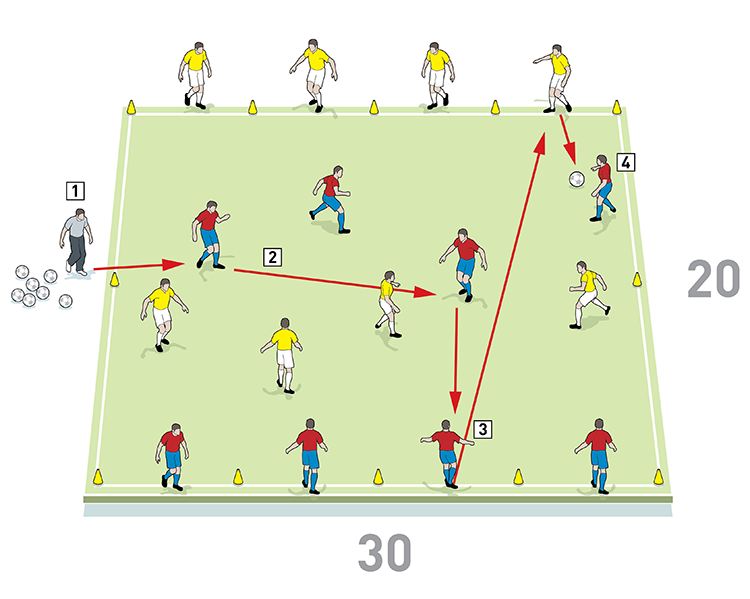
2. The pass is switched to the left before being threaded through to the defensive line
3. A straight pass is made to the other side
The coach serves the ball in from the side and this prompts a 4v4 possession game inside the area. Each team attempts to play forwards into their target players. If successful, target players will switch to the opposite side, and possession is then recycled back into the same team.
If unsuccessful in making the switch, or the ball goes out of play (2), the coach serves a ball in to the opposing team who now attempt the challenge. Players inside the area rotate with target players at the end of each set.
2
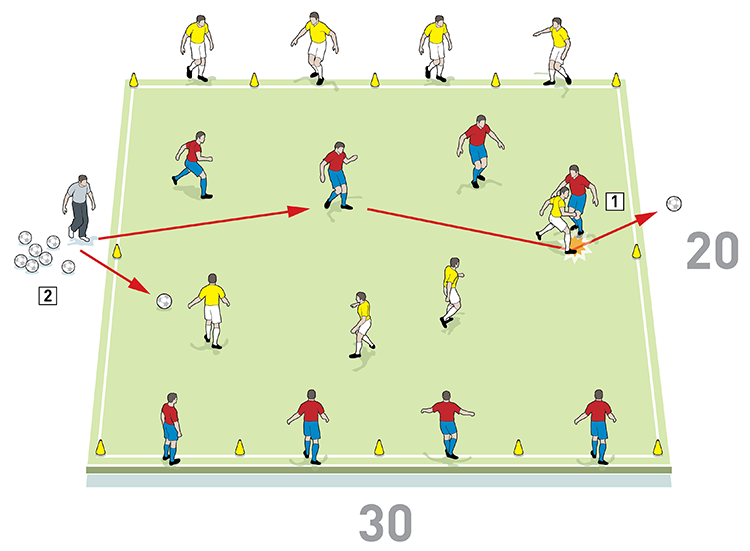
2. The coach restarts the move by serving in to the yellows
How do I progress the session?
We now move into a third of a pitch, as shown (3), with a match-specific practice. Essentially we have two working units (one on each side) that, together, represent four defenders and two midfielders attempting to play out into the target goals or players. Opposition players can confront them in a preferred formation (for instance, two forwards, two wide players and two midfielders), and upon gaining possession may attack the goal.
3
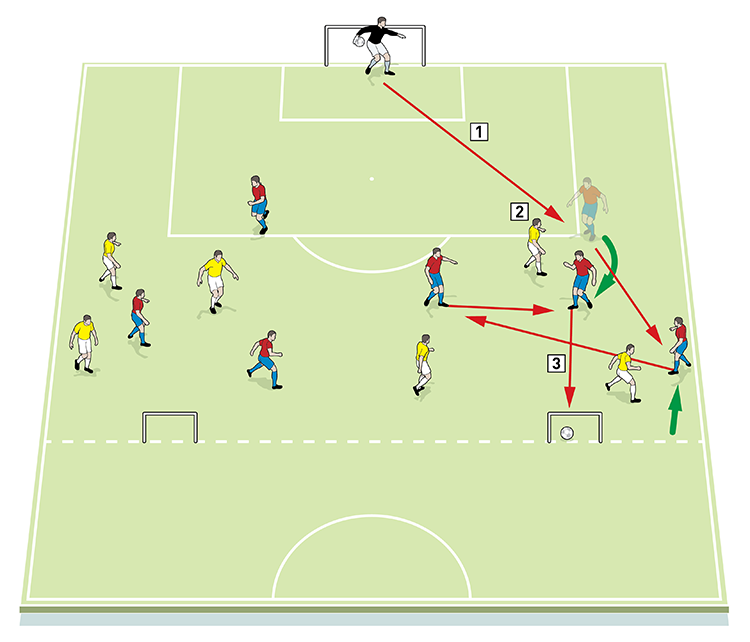
2. Yellow defenders are too slow to press their opponents
3. Red/blues link up well and score in the target goal
What are the key things to look out for?
For individuals, the task helps fine-tune the art of reading triggers to press, along with blocking the line of the pass into the target and pressing with intensity (4).
4
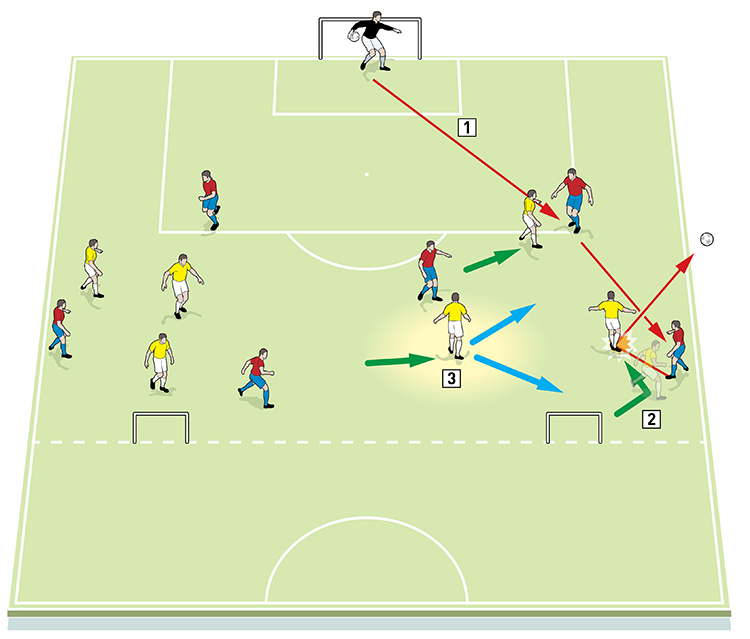
2. Yellows press quickly, successfully intercepting the danger
3. Covering yellows also operate well – this player not only presses his man, but blocks potential passing and shooting lines also
For the units, the practice is about communication and encouragement, plus rehearsal of depth and cover behind the press.
There are a few common faults that we tend to see, namely that players don’t get close enough to opponents and allow passes to be played forwards. In contrast, players can press quickly but don’t block the line of the pass into the target player. Finally, attackers must be encouraged to switch should the need arise (5).
5

2. Yellows press the ball well and force the ball back
3. Reds/blues are unsettled and must switch the ball to evade the attentions of their opponents
How do I put this into a game situation?
We set up as shown (6) in the space between the penalty areas, using a 6v6 plus keepers. We play as we would a normal game, though players are encouraged to use the defensive line(s) as a trigger point to press from.
6
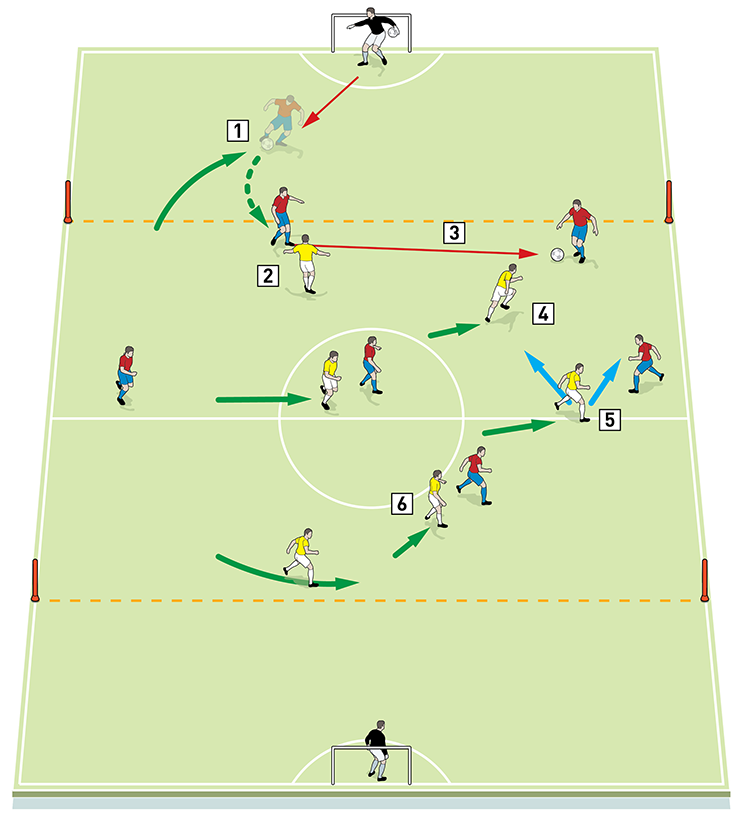
2. As soon as he advances past the trigger line the yellow attacker presses
3. The defender is forced into playing a square pass
4. Midfielders move to press the player on the ball
5. Other midfielders move across and should be aware of blocking passing lines
6. Centre-backs move across to cover the forward dropping deep
Related Files
Editor's Picks
Attacking transitions
Deep runs in the final third
Using the goalkeeper in build-up play
Intensive boxes drill with goals
Penetrating the final third
Creating and finishing
My philosophy
Pressing initiation
Compact team movement
Coaches' Testimonials

Alan Pardew

Arsène Wenger

Brendan Rodgers

Carlos Carvalhal

José Mourinho

Jürgen Klopp

Pep Guardiola

Roy Hodgson

Sir Alex Ferguson

Steven Gerrard
Coaches' Testimonials

Gerald Kearney, Downtown Las Vegas Soccer Club

Paul Butler, Florida, USA

Rick Shields, Springboro, USA

Tony Green, Pierrefonds Titans, Quebec, Canada
Join the world's leading coaches and managers and discover for yourself one of the best kept secrets in coaching. No other training tool on the planet is written or read by the calibre of names you’ll find in Elite Soccer.
In a recent survey 92% of subscribers said Elite Soccer makes them more confident, 89% said it makes them a more effective coach and 91% said it makes them more inspired.
Get Monthly Inspiration
All the latest techniques and approaches
Since 2010 Elite Soccer has given subscribers exclusive insight into the training ground practices of the world’s best coaches. Published in partnership with the League Managers Association we have unparalleled access to the leading lights in the English leagues, as well as a host of international managers.
Elite Soccer exclusively features sessions written by the coaches themselves. There are no observed sessions and no sessions “in the style of”, just first-hand advice delivered direct to you from the coach.







